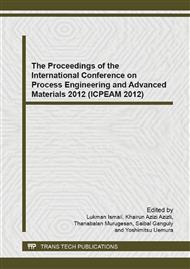[1]
B.L. Yeap, Design of Heat Exchanger Networks with Fouling Mitigation. in CGPS dissertation: University of Cambridge , UK, (2001).
Google Scholar
[2]
B.D. Crittenden, S.T. Kolaczkowski, Mass transfer and chemical kinetics in hydrocarbon fouling. Proc. Conf. on fouling science or art?, Guildford, Inst. of cor. Sci. and tech. and Ins. of Chem. Engs, London, (1979) 169-187.
Google Scholar
[3]
T.R. Bott, Fouling of heat exchangers. Elsevier Science B.V., (1995).
Google Scholar
[4]
W.A. Ebert, C.B. Panchal, Analysis of Exxon crude-oil slip stream coking data, Fouling mitigation of industrial exchange equipment, Begell House, NY, (1995) 451-460.
Google Scholar
[5]
C.B. Panchal, W.C. Kuru, C.F. Liao, W.A. Ebert, J.W. Palen, Threshold conditions for crude oil fouling. Proc. of understanding heat exchanger fouling and its mitigation, Engineering foundation conference, Lucca, Italy, (1997).
Google Scholar
[6]
G.T. Polley, D.I. Wilson, B.L. Yeap, S.J. Pugh, Evaluation of laboratory crude oil threshold fouling data for application to refinery preheat trains, Applied Thermal Eng. 22 (2002) 777-788.
DOI: 10.1016/s1359-4311(02)00023-6
Google Scholar
[7]
M.R. Nasr, M.M. Givi, Modeling of crude oil fouling in preheat exchangers of refinery distillation units, Applied Thermal Eng. 26 (2006) 1572-1577.
DOI: 10.1016/j.applthermaleng.2005.12.001
Google Scholar
[8]
B.D. Crittenden, S.T. Kolaczkowski, S.A. Hout, Modelling hydrocarbon fouling, Trans. IChemE Part A. 65 (1987) 171-179.
Google Scholar
[9]
M.C. Georgiadis, L.G. Papageorgiou, S. Macchietto, Optimal cyclic cleaning scheduling in heat exchanger networks under fouling, Computers & Chemical Eng. 23 (1999) S203-S206.
DOI: 10.1016/s0098-1354(99)80050-7
Google Scholar
[10]
F. Smaïli, V.S. Vassiliadis, D.I. Wilson, Mitigation of fouling in refinery heat exchanger networks by optimal management of cleaning, Energy & Fuels. 15 (2001) 1038-1056.
DOI: 10.1021/ef010052p
Google Scholar
[11]
S. Sanaye, B. Niroomand, Simulation of heat exchanger network (HEN) and planning the optimum cleaning schedule, Energy Conversion and Managmt. 48 (2007) 1450-1461.
DOI: 10.1016/j.enconman.2006.12.006
Google Scholar
[12]
E.M. Ishiyama, A.V. Heins, W.R. Paterson, L. Spinelli, D. I. Wilson, Scheduling cleaning in a crude oil preheat train subject to fouling: Incorporating desalter control, Applied Thermal Engg. 30 (2010) 1852-1862.
DOI: 10.1016/j.applthermaleng.2010.04.027
Google Scholar
[13]
A.P. Watkinson, D.I. Wilson, Chemical reaction fouling: A review, Experimental Thermal and Fluid Sci. 14 (1997) 361-374.
DOI: 10.1016/s0894-1777(96)00138-0
Google Scholar
[14]
Z.S. Saleh, R. Sheikholeslami, A.P. Watkinson, Fouling characteristics of alight Australian crude oil, Heat Transfer Eng. 26(1) (2005) 15-22.
DOI: 10.1080/01457630590890049
Google Scholar
[15]
W.R. Paterson, P.J. Fryer, A reaction engineering approach to the analysis of fouling, Chem. Eng. Sci. 43 (1988) 1714-1717.
DOI: 10.1016/0009-2509(88)85166-2
Google Scholar
[16]
N. Epstein, A Model of the Initial Chemical Reaction Fouling Rate for Flow Within a Heated Tube and its Verification, Proc. 10th International Heat Transfer Conference, Brighton, U. K, (1994).
DOI: 10.1615/ihtc10.2810
Google Scholar
[17]
P. Eaton, R. Lux, Laboratory fouling test apparatus for hydrocarbon feedstocks, Fouling in heat exchange equipment, ASME HTD. 35 (1984) 33-42.
Google Scholar
[18]
S. Asomaning, Heat exchanger fouling by petroleum asphaltenes, PhD thesis, University of British Columbia, (1997).
Google Scholar
[19]
A.S. Kovo, Mathematical modeling and simulation of fouling of Nigerian crude oil equipment installations, Leonardo Journal of Sci. 9 (2006) 111-124.
Google Scholar
[20]
G.B. Dickakian, S. Seay, Asphaltene precipitation primary crude exchanger fouling mechanism, Oil and Gas J. 86 (1988) 47-50.
Google Scholar
[21]
A.P. Watkinson, Chemical reaction fouling of organic fluids, Chem. Eng. Tech. 15 (1992) 82-90.
Google Scholar
[22]
B.J. Fuhr, C. Cathrea, L. Coates, H. Kalra, A.I. Majeed, Properties of asphaltenes in waxy crude, Fuel. 70 (1991) 1293-1297.
DOI: 10.1016/0016-2361(91)90216-w
Google Scholar
[23]
G.A. Lambourn, M. Durrieu, Fouling in crude oil preheat trains, Heat exchangers theory and practice, Taborek , Hewitt and Afghan (eds. ) Hemisphere, NY, (1983) 841-852.
DOI: 10.1615/ichmt.1981.advcourseheatexch.540
Google Scholar
[24]
C.A. Bennett, A Theory Describing Asphaltene Adhesion Fouling Inside Heat Exchanger Tubes, Heat Transfer Engg. 33(15) (2012) 1246-1250.
DOI: 10.1080/01457632.2012.692295
Google Scholar
[25]
J.G. Knudsen, D. Lin, W.A. Ebert, The determination of a threshold fouling curve for crude oil, Understanding heat exchanger fouling and its mitigation, T.R. Bott (eds. ) Begell House, NY, (1999) 265-272.
Google Scholar


